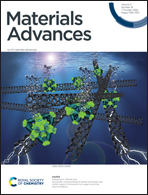Multifaceted ligand design facilitates chemical- or peptide-mediated linking of hollow gold nanoshells with tuned interparticle distance, interference and cytotoxicities†
Abstract
We report a versatile methodology to covalently link hollow gold nanoshells (HAuNS) through modular design of multi-tasking ligands and bio-adaptable chemistry. The biocompatible ligand composition includes strategically placed two polyethylene glycol (PEG) chains, protected thiol-terminated tetraethylene glycol, and a reactive functional group, on a core. HAuNS are functionalized through an in situ one-pot deprotection/thiol-Au binding. The ligand-functionalized HAuNS with surface exposed COOH or OH entities are employed in constructing linked-HAuNS conjugated through a short chemical- or a longer bio-spacer (GPLGVRG peptide), in which (i) the length of the PEG chains plays an important role in minimizing oligomerization during covalent linking of HAuNS; (ii) inter-particle distance and interference of HAuNS surface plasmon resonance are regulated through chemical/peptide junctions, with UV-Vis-NIR absorption maxima red-shifted in chem-linked HAuNS; and (iii) chem-linked HAuNS-to-monomer conversion leads to amplification of the photoacoustic signal. Ligand stabilized monomeric and linked-HAuNS are less cytotoxic than citrate protected HAuNS. The synthetic tools and facile chemistry described here provide opportunities in designing linked metal nanoparticles for broad applications in biology.



 Please wait while we load your content...
Please wait while we load your content...